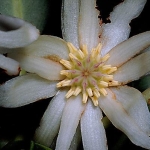| Common Name: |
Star Anise |
| Other Names: |
Badian |
| Botanical Name: |
Illicium verum |
| Genus: |
Illicium |
| Family: |
Illiciaceae |
| Native Location: |
S China, N Vietnam |
| Cultivation: |
Moist, well-drained, neutral to acid soil in partial shade. |
| Propagation: |
By semi-ripe cuttings in summer. |
| Harvest: |
Fruits are collected unripe for chewing, and ripe for oil distillation or use in decoctions and powders. |
| Height: |
18m (60ft) |
| :Width |
7-12m (22-40ft) |
| Hardiness: |
Z8 |
| Parts Used: |
Fruits (ba jiao hui xiang), oil. |
| Properties: |
A warm, stimulant herb that benefits the digestion, releives pain, and has anti-fungal and anti-bacterial effects. |
| Medicinal Uses: |
Internally for abdominal pain, digestive disturbances, and complaints associated with cold conditions (such as lumbago). Often included in remedies for digestive disturbances and cough mixtures, and as aniseed flavoring for medicines. Excess causes trembling and convulsions, due to the high content of anethole (80-90 percent) in the essential oil. |
| Culinary Uses: |
Ripe fruits are used to flavor curries, tea, and pickles; also an ingredient of "five spice powder" in Chinese and Vietnamese cuisine. Unripe fruits are chewed after meals as a digestive and breath sweetener in the East. |
| Economic Uses: |
Ripe fruits are used to flavor coffee and candy. Essential oil is used to flavor liqueurs, soft drinks, and bakery products. |
| Bibliography: |
Encylopedia of Herbs by Deni Bown Copyright ©: 1995, 2001 Dorling Kindersley Limited pg 242
|

